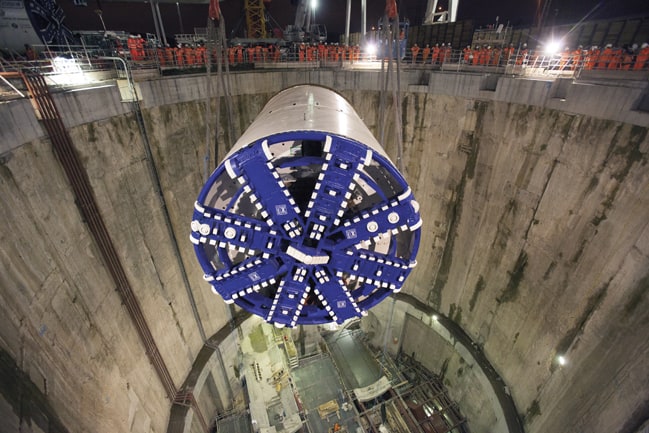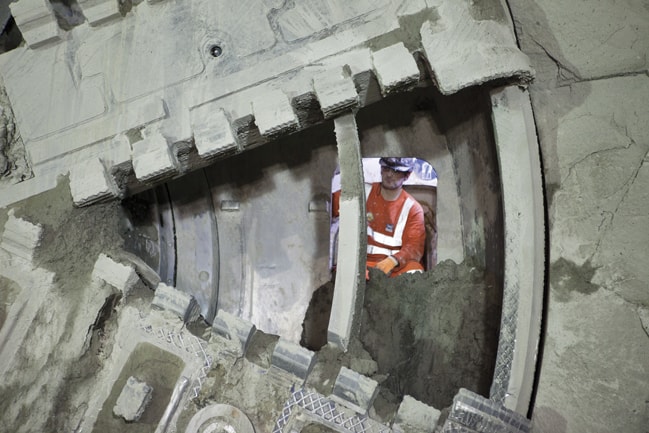with Crossrail 1. Andrew Wade reports
![Michele Dix[2] copy](/media/r1zpa0jk/michele-dix2-copy.jpg)
Crossrail 2, a landmark north-south link across the UK’s capital was recently granted £80m in development funding in the Budget, although this is a drop in the ocean next to the project’s estimated final cost of £32bn. In a time of continued austerity, figures such as this are eye-watering. However, Crossrail 2’s supporters argue that it will not only bring relief to London’s creaking transport network, it will also add huge economic value by unlocking new corridors for much needed housing and development.
Support for the project is widespread. Usual concerns have been raised about London turning into a giant building site, but, as any resident can attest to, the city is in a permanent state of flux. A key factor giving Crossrail 2 momentum has been the success so far of Crossrail 1, recently christened the Elizabeth Line. Due to open in late 2018, tunnelling was completed in June last year, and the project has been praised for the minimal disruption caused in relation to the scope of the engineering works.
“The fact it’s been a success makes it easier for us in having some of the conversations with people about the construction of Crossrail 2 and how it won’t be as disruptive as people may have feared,” Michèle Dix, managing director of Crossrail 2, told The Engineer. “It’s great that there’s a live scheme out there that people can see and visit, and understand how it has worked.”
The core central section of the line will run underground from New Southgate and Tottenham Hale in the north to Wimbledon in the south, but the exact route is yet to be finalised. One point of debate is whether the line will travel via Tooting Broadway or Balham. The former was the original preferred option, but complications with soil at Tooting led to the Balham route being put forward. A final recommendation won’t be made until the summer at the earliest.
“The challenge that we have in the south of London is the fact you’ve got the Wimbledon fault lines,” said Dix. “There you go from clay, to sand, to pebbly stuff, and that makes building a station in those conditions much more difficult.
“We’ve had quite a lot of consultation responses wanting us to still consider Tooting Broadway, despite the concerns expressed, and we are doing studies to further understand the engineering challenges, as well as the socio-economic impacts of both stations before drawing any conclusions.”
During the most recent consultation over 10,000 comments on the Balham station were submitted, with nearly 9,000 raising issues or concerns. Only one station – King’s Road Chelsea – attracted more attention. It received almost 15,000 comments, with over 85 per cent of them containing issues and concerns.

Long considered a key location since the proposed Chelsea-Hackney (or Chelney) line that predates Crossrail 2, the King’s Road station has proved highly controversial. On the plus side, it would help connect a long underserved part of the city to the underground network, improving links to the nearby Royal Brompton and Royal Marsden hospitals, and helping to reduce road congestion. But with no London Underground or National Rail links already in place, residents argue the brand-new £1.2bn station would be a folly, causing unnecessary disruption to the area.
In a report produced in March, the National Infrastructure Commission (NIC) said the station “does not provide the strategic interchange or crowding relief provided by other stations”. An alternative at Imperial Wharf has been mooted, but, for now at least, King’s Road Chelsea remains firmly part of the project’s plans.
“A station at King’s Road would have local benefits,” Dix said. “It would serve an area that’s not served by public transport at present – the King’s Road itself, the shopping area and the hospitals that are subject to redevelopment. Growth will take place in the future and the King’s Road station would help. But what the NIC has asked us to do is to look at the costs of Crossrail 2, and to look at each of the central stations to understand the case for each.”
There appears to be no apprehension with regard to the Eastern branch. Although it will not form part of the initial development, calls are already coming from east London boroughs for a commitment to the extension. A spur running from just north of Angel to Hackney Central has already been safeguarded, and if/when it goes ahead, will likely run through Newham and into Essex. But with plenty of development already underway in that part of the capital, eastward expansion is not an immediate priority.

“There might be a case for an Eastern branch at a later date,” said Dix. “Many eastern boroughs feel that there is. But it wouldn’t be part of the first-phase scheme. It’s just not developed. There’s no route alignment, there’s no engineering work. To get to the stage where we are with the core scheme – we’ve been looking at this since 2009, and we’ve had four rounds of consultation already.
“Part of our case to the DfT [Department for Transport] needs to be that we’ve exhausted all other possibilities. It’s not just a case of ‘oh, let’s just have a big scheme in the south-west to north-east corridor’. It’s reviewing that corridor to relieve the south-west mainland trains, to resolve the problems of increased congestion in the centre, and open up the whole of that north-east corridor.”
When the work finally does get underway, the current assumption is that the tunnels will be drilled to the same 6.2m diameter as Crossrail 1, with the same rolling stock running on both lines. One area that Dix and her colleagues may look to alter is the venting shafts, where a slightly different size tunnel may help improve the ventilation flow.
It’s one of many decisions on the table in an upcoming cost review to investigate where potential savings can be made in the overall scheme. The NIC report recommended that London raise at least half of the project finance itself. Dix is confident this figure can be met through a range of similar levies taken to fund Crossrail 1. Furthermore, she believes the long-run return to the Treasury on its funding will end up being a multiple of the initial outlay.
With the line unlikely to open before 2032, those receipts won’t be seen anytime soon, but this is exactly the type of long-term investment required to prevent gridlock in the capital. Here’s wishing it every success.
Career CV
Michèle Dix CBE
Managing Director, Crossrail 2
Started her career at the Greater London Council and became a chartered civil engineer through their transport planning graduate scheme.
Later went on to work for Halcrow Fox, where she became a board director.
Joined TfL in 2000 as co-director of Congestion Charging.
Became managing director of Planning at TfL in 2007, responsible for leading the planning strategy on the future transport needs of London, coordinating the implementation of local plans and borough partnerships, and developing major scheme initiatives.
Appointed managing director of Crossrail 2 in February 2015, and is currently responsible for developing Crossrail 2 and gaining funding and powers for it.




Red Bull makes hydrogen fuel cell play with AVL
Formula 1 is an anachronistic anomaly where its only cutting edge is in engine development. The rules prohibit any real innovation and there would be...